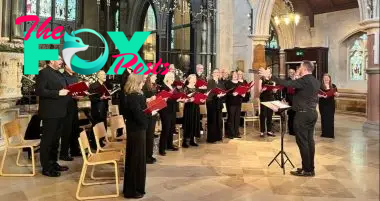Entertainment
Saint Cecilia Singers premiere an essential and transferring new work by Neil Cox in Gloucester – Seen and Heard Worldwide
 United Kingdom Byrd, Cox, Williams, Allegri, Bernstein: Tom Lilburn (countertenor), Piers Maxim (organ), Laura Morris (French horn), Cecily Beer (harp), Jack Redman (keyboard), Diggory Seacome, Anna Newman (percussion), Ivan Barritt (sound engineer); Saint Cecilia Singers / Jonathan Hope (conductor). Gloucester Cathedral 22.3.2024. (JQ)
United Kingdom Byrd, Cox, Williams, Allegri, Bernstein: Tom Lilburn (countertenor), Piers Maxim (organ), Laura Morris (French horn), Cecily Beer (harp), Jack Redman (keyboard), Diggory Seacome, Anna Newman (percussion), Ivan Barritt (sound engineer); Saint Cecilia Singers / Jonathan Hope (conductor). Gloucester Cathedral 22.3.2024. (JQ)

Byrd – Ave Verum Corpus
Neil Cox – Requiem Canticles (world premiere)
Roderick Williams – Ave Verum Corpus Reimagined
Allegri – Miserere
Bernstein – Chichester Psalms
Donald Hunt (1930-2018) is especially remembered because the distinguished Organist of Worcester Cathedral, a publish he held from 1976 to 1996. Proper firstly of his profession he served as Assistant Organist at Gloucester Cathedral and through that point he based the Saint Cecilia Singers (SCS) in 1949. The choir, which numbers round thirty singers, has gone on to determine a fame as an elite chamber choir, performed by Hunt’s numerous successors at Gloucester Cathedral. The current Creative Director is Jonathan Hope, Assistant Director of Music at Gloucester Cathedral since 2014. This live performance was a celebration of the seventy fifth anniversary of the SCS.
The programme opened with Byrd’s beautiful Ave Verum Corpus. I assumed Jonathan Hope paced the music in a great vogue; he and his singers ensured that each vocal line emerged clearly. The concluding ‘Amen’ sounded magical within the cathedral’s resonant acoustic.
I’ve been ready to listen to Neil Cox’s Requiem Canticles for 4 years. It was commissioned by SCS to mark their seventieth anniversary and the premiere was scheduled for March 2020; within the occasion, simply days earlier than the live performance was attributable to happen the UK was put into the primary Covid lockdown. The ensuing lengthy delay will need to have been equally irritating for the composer and for SCS, although I perceive that in this era Cox took the chance to make some revisions to his rating. Neil Cox’s title is probably not as broadly often called it deserves to be. Born in South Wales in 1955, he was an Organ Scholar at Cambridge, after which he taught at Lancing School, Sussex; he turned Director of Music there in 1978 and after 41 years at Lancing School, he retired to Gloucester. I’ve heard a lot of items by him, together with his choral work CoNFLict in Heaven, some church music – which was recorded by the Choir of Gloucester Cathedral – and a few songs which James Gilchrist sang a number of years in the past. These earlier encounters with Cox’s music had whetted my urge for food to listen to Requiem Canticles.
The work, which on this efficiency performed for 36 minutes, is solid in eight sections. Cox defined in a programme observe that the fee ‘gave me the chance to revisit a few of my work from the previous, to include it into an even bigger work alongside new actions, and to construct the construction anew’. I’m not able to say which elements of Requiem Canticles are recycled from previous music but when the composer’s comment suggests a patchwork rating, I can solely say that, although the actions have been differentiated from one another, I discovered on a primary listening to that the rating had a cohesive unity. Moreover, an essential structural gadget was the revisitation within the final motion of fabric heard on the very opening of the work (a tool which, by coincidence, Bernstein additionally adopted in Chichester Psalms).
Requiem Canticles is scored for solo countertenor, SATB choir and a small ensemble. The ensemble consists of horn, harp, percussion (2 gamers), keyboard and organ. There may be one extra and essential component. Within the first and final actions Cox has included the sound of recorded church bells and, furthermore, the bells of a really particular church. He defined in his observe that in 2016 he visited the German metropolis of Speyer. There, the immense Romanesque Cathedral has a peal of bells which Cox described as ‘all-encompassing’; a lot in order that he recorded them on his iPad and it’s that recording which he included into Requiem Canticles. I believe it’s price saying two issues about Cox’s use of a reasonably small instrumental ensemble. Firstly, it’s a very pragmatic choice at a time when choirs discover their funds below stress; placing on a efficiency of Requiem Canticles received’t break the financial institution. Secondly, although solely a small group of devices is concerned, the vary of colors and textures is by no means inhibited; somewhat, Cox appears to search out unerringly the suitable – and thrilling – instrumental timbres at each level within the rating.
The primary two actions, ‘Requiescant – Kyrie’ and ‘Dies irae’ set Latin phrases from the Mass for the Useless. A tense ambiance was distilled proper firstly within the instrumental introduction, however as soon as the choir started to sing, I assumed there was heat within the harmonies. Cox units solely the primary 4 stanzas of the ‘Dies irae’ (reaching so far as ‘Mors stupebit’). The music could be very dramatic and intense. There was an issue of steadiness, although. Right here, and within the first motion, the ensemble usually drowned the choir. I may see that the singers have been articulating punchy rhythms however what they have been singing was not sufficiently audible. I believe that at future performances these issues can be averted if both the choir was bigger and/or positioned on raised staging – ideally each.
The ‘Dies irae’ led with no break right into a setting of the poem ‘Imagined Voices’ by the Greek poet, Constantine Cavafy (1863-1933). This supplied much-needed distinction with the tumult of the ‘Dies irae’, not solely when it comes to the feelings expressed but in addition within the music itself. The motion is for the solo counter tenor, whose music could be very evenly accompanied. The soloist, Tom Lilburn, is a Lay Clerk at St George’s Chapel. He was glorious on this Cavafy setting; his plangent tone rang out effortlessly down the cathedral nave and the sheer sound of his voice was ideally suited to Cox’s music. There was a pared-back simplicity to this motion which appealed strongly. The following motion, once more evenly scored, is a setting for the choir of Psalm 23. It is a radiant piece. The melodic invention is gorgeous and the harmonies superbly imagined. It’s a high quality response to the phrases of the psalm and I had the impression that the members of SCS had taken this music to their hearts.
Tom Lilburn returned for motion 5, ‘Sanctus’. Initially, the choir supplied a backdrop to his solo line; hereabouts the instrumental accompaniment to the soloist was gamelan-like. At ‘Pleni sunt cæli’ the choir’s music had a lot better depth and vitality; I used to be put in thoughts of the identical passage in Britten’s Conflict Requiem. There follows a hymn-like setting of Psalm 121 (‘I to the hills carry up mine eyes’). The supply for the phrases is the New England Bay Psalter (1640), the primary ebook printed in British North America (so I realized from Neil Cox’s observe). The music is handled in another way in every of the 4 verses; I assumed it was a really efficient setting, mirroring properly each the Psalm itself and the seventeenth-century English.
The Psalm was adopted attacca by a setting of well-known traces from St Paul’s Epistle to the Corinthians (‘Although I converse with the voice of angels and mortals however haven’t love…’) Initially, the phrases are sung by the soloist – Lilburn was actually eloquent right here – with a fragile instrumental accompaniment and the choir gently within the background. The choir moved to the fore at ‘Love is the voice of endurance and kindness’; right here, the phrases have been set to a profitable, heat melody. The music constructed to a robust affirmation earlier than the soloist had the final phrase (actually), thrice singing very quietly the phrase ‘Love’. By the use of a beautiful organ transition, the ultimate motion adopted with no break. Right here, Cox attracts the entire work collectively. The choir sings ‘The Resurrection Prayer’ of St Augustine of Hippo (‘We will relaxation and we will see…’) The choir’s music is homophonic, very stunning and has an unquestionable sincerity. St Augustine’s prayer ends with ‘Amen, Alleluia’ which Cox makes right into a heat and spectacular climax. Then, he revisits the fabric of the work’s opening, together with the Speyer bells, earlier than Requiem Canticles achieves a hushed and really satisfying conclusion. A silence adopted, indicating how the music had resonated with the viewers; we wanted a bit of time to digest it.
Nei Cox has composed a most spectacular and transferring work. An impressed collection of texts and ingenious, engaging music exerted a robust attraction to the viewers who accorded each composer and work an enthusiastic ovation. I’m positive everybody felt, as I did, that we had been current on the unveiling of an essential composition. I’m impatient to listen to it once more and I hope different choirs will take it up. I must be significantly to listen to it sung by a bigger choir. That’s not to recommend for a second that the efficiency by the Saint Cecilia Singers was insufficient in any manner – their singing was assured, achieved and dedicated all through – however while the work is admirably suited to a chamber choir, a bigger vocal ensemble would add a unique dimension to the music.
Having opened the live performance with Byrd’s Ave Verum Corpus, it was a shrewd little bit of programme planning by Jonathan Hope to start the second half with Roderick Williams’ Ave Verum Corpus Reimagined. Over the previous few years, Suzi Digby and the ORA Singers have carved out a distinct segment by inviting composers to write down new works impressed by items of Tudor and Renaissance polyphony. Roderick Williams’ Byrd-inspired piece was one of many very first and, although I’ve heard and admired many subsequent new works commissioned by ORA, Williams’ composition is, I believe, nonetheless probably the greatest. I’ve admired it since I heard its debut recording (overview). Williams designed the piece for 3 choirs. On this event the bodily separation of the three teams was not very pronounced however one may nonetheless hear the three parts distinctly. I really like the best way Williams retains Byrd’s unique music very firmly in our earshot however makes use of it as a springboard to discover spatial and harmonic potentialities. I assumed that Hope and the SCS gave a high quality account of this most imaginative tribute to William Byrd.
Allegri additionally makes use of spatial differentiation in his celebrated Miserere. For this, Jonathan Hope despatched the solo quartet deep into the cathedral quire. Standing on the foot of the excessive altar steps, they have been a great distance from the primary ensemble, who have been positioned in entrance of the organ display. The quartet was not too distant that their voices couldn’t be heard clearly, however the distancing was best. I acknowledge I’m in a minority, however I believe that on this piece Allegri makes a bit of musical materials go an awfully great distance. This efficiency did nothing to alter my thoughts, although I did admire the ability of the singing and I appreciated the best way Jonathan Hope injected momentum into the music.
It will need to have appeared incongruous when in 1965 the Dean of Chichester, Walter Hussey (1909-1985) commissioned Leonard Bernstein to write down a choral work for the cathedral’s Music Pageant. Hussey was a beneficiant, wide-ranging and far-sighted patron of the humanities, each when he was Vicar of St Matthew’s Northampton and later Dean of Chichester. Among the many essential works we owe to his patronage are Britten’s Rejoice within the Lamb, Finzi’s Lo, the total, last sacrifice and visible works by artists corresponding to Henry Moore and Graham Sutherland. Nonetheless, even with such a observe report it was a daring transfer for Hussey to strategy the composer of West Facet Story. As luck would have it, Hussey’s request got here when Bernstein was taking a sabbatical from his function as Music Director of the New York Philharmonic to be able to concentrate on composition. One suspects that the fee to write down what turned a group of three actions of psalm settings gave Bernstein a welcome alternative to specific in music his Jewish heritage. The unique model of Chichester Psalms is scored for treble soloist, SATB choir and an orchestra of strings, two harps, brass and percussion however this efficiency used the composer’s personal discount for harp, organ and percussion. Although Bernstein conceived the solo function for a treble it has change into not less than as frequent for a countertenor to sing the function, as right here; I choose that strategy.
I felt that the efficiency of the primary of the three actions was not completely profitable. Although the work was written for efficiency in a cathedral (at Chichester), a resonant acoustic can blunt the vigorous choral writing and, regardless of the energetic response of SCS that occurred right here. This music ideally wants a crisper acoustic. The principal drawback, although, was that the organ sound was muddy and lacked the readability which strings would have delivered to the music. The percussion, too, lacked crispness, although I believe this was the ‘fault’ of the acoustic somewhat than the gamers. All such considerations have been banished, nonetheless, within the second motion, which is principally a setting for the soloist of Psalm 23. Tom Lilburn gave a fully excellent efficiency. He sang with nice expression and a beautiful purity of tone, his voice hovering in a most affecting manner. After the efficiency I talked to a buddy of mine, a seasoned singer and vocal instructor, who mentioned she had by no means heard this solo sung higher. I can solely agree; it was the spotlight of your entire night. Within the concluding motion, Bernstein reveals no little compositional ability in bringing again materials from the primary two actions and weaving them into his design. However what makes the motion so memorable is the great melody to which he units the phrases from Psalm 131. The tune is like an endlessly flowing stream and it blossomed within the heat Gloucester Cathedral acoustic. Bernstein’s hushed ending transforms the jagged motif heard on the very begin of the work into one thing that’s pacific and profound. As had been the case with the Cox piece, a respectful silence rightly adopted this dedicated efficiency.
With this live performance, the Saint Cecila Singers marked their seventy fifth anniversary in nice fashion. Jonathan Hope had ready them very rigorously for this programme and he performed the big selection of music most successfully. The choir can take nice satisfaction, not simply from the excellence of their performances but in addition from the truth that their anniversary fee has resulted in a brand new work which deserves to change into an essential addition to the choral repertoire.
John Quinn
-

 Entertainment5h ago
Entertainment5h ago4Minutes and Other New Thai BL Series to Watch in 2024
-

 Entertainment5h ago
Entertainment5h agoThe True Story Behind Netflix’s Unfrosted, Jerry Seinfeld’s Pop-Tarts Movie
-

 Entertainment6h ago
Entertainment6h ago5 Must See Car Shows this Year in New York
-

 Entertainment7h ago
Entertainment7h ago‘GOATs’ Patrick Mahomes and LeBron James pal around at star-studded Carbone Beach party
-

 Entertainment7h ago
Entertainment7h agoTravis Kelce goes casual in green as he continues solo weekend at F1’s Miami Grand Prix without Taylor Swift
-

 Entertainment12h ago
Entertainment12h agoPopular Hudson Valley Health Food Store Closes After 50 Years
-

 Entertainment13h ago
Entertainment13h agoInside Derek Jeter and wife Hannah’s romantic Formula 1 weekend date night: ‘They looked so happy’
-

 Entertainment13h ago
Entertainment13h agoRobert Kraft takes out full-page ads in major papers for his foundation against antisemitism























